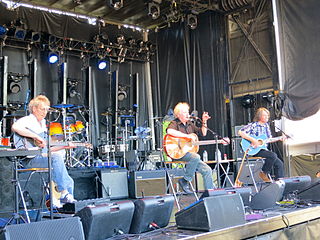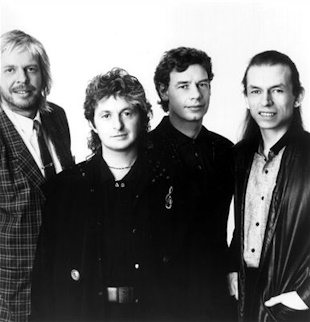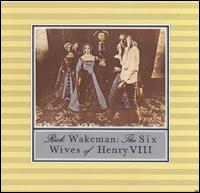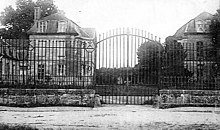
Yes are an English progressive rock band formed in London in 1968 by lead singer Jon Anderson, bassist Chris Squire, guitarist Peter Banks, keyboardist Tony Kaye, and drummer Bill Bruford. The band has undergone numerous lineup changes throughout their history, during which 20 musicians have been full-time members. Since February 2023, the band has consisted of guitarist Steve Howe, keyboardist Geoff Downes, bassist Billy Sherwood, singer Jon Davison, and drummer Jay Schellen. Yes have explored several musical styles over the years and are most notably regarded as progressive rock pioneers.

Richard Christopher Wakeman is an English keyboardist and composer best known as a former member of the progressive rock band Yes across five tenures between 1971 and 2004, and for his solo albums released in the 1970s. AllMusic describes Wakeman as a "classically trained keyboardist extraordinaire who plied his trade with Yes and developed his own brand of live spectacular in a solo act."

John Roy Anderson is an English singer, songwriter and musician, best known as the former lead singer of the progressive rock band Yes, which he formed in 1968 with bassist Chris Squire. He was a member of the band across three tenures until 2008. Anderson was also a member of ARW along with former Yes bandmates Rick Wakeman and Trevor Rabin from 2016 to 2020. Together with bassist Lee Pomeroy and drummer Lou Molino III, they toured under the name Yes Featuring Jon Anderson, Trevor Rabin, Rick Wakeman.

The Tubes are a San Francisco-based rock band. Their self-titled 1975 debut album included the single "White Punks on Dope", while their 1983 single "She's a Beauty" was a top-10 U.S. hit and its music video was frequently played in the early days of MTV. The band also performed in the 1980 film Xanadu, singing the rock portion of the cross-genre song "Dancin'" opposite a big band.

Tales from Topographic Oceans is the sixth studio album by English progressive rock band Yes, released on 7 December 1973 by Atlantic Records. It is their first studio album to feature drummer Alan White, who had replaced Bill Bruford the previous year. Frontman Jon Anderson devised its concept during the Close to the Edge Tour, when he read a footnote in Autobiography of a Yogi by Paramahansa Yogananda that describes four bodies of Hindu texts about a specific field of knowledge, collectively named shastras–śruti, smriti, puranas, and tantras. After pitching the idea to guitarist Steve Howe, the pair spent the rest of the tour developing an outline of the album's musical themes and lyrics.

Trevor Charles Rabin is a South African musician, songwriter, and film composer. Born into a musical family and raised in Johannesburg, Rabin took up the piano and guitar at an early age and became a session musician, playing and producing with a variety of artists. In 1972, he joined the rock band Rabbitt, which enjoyed considerable success in South Africa, and released his first solo album, Beginnings. In 1978, Rabin moved to London to further his career, working as a solo artist and a producer for various artists including Manfred Mann's Earth Band.

The Strawbs are an English rock band founded in 1964 as the Strawberry Hill Boys. The band started out as a bluegrass group, but eventually moved on to other styles such as folk rock and progressive rock.

Anderson Bruford Wakeman Howe (ABWH) were an English progressive rock band active from 1988 to 1990 that comprised four past members of the English progressive rock band Yes. Singer Jon Anderson left Yes as he felt increasingly constrained by their commercial and pop-oriented direction in the 1980s. He began an album with other members from the band's 1970s era: guitarist Steve Howe, keyboardist Rick Wakeman, and drummer Bill Bruford, plus bassist Tony Levin.

Going for the One is the eighth studio album by English progressive rock band Yes, released on 15 July 1977 by Atlantic Records. After taking a break in activity in 1975 for each member to release a solo album, and their 1976 tour of the United States and Canada, the band relocated to Montreux, Switzerland to record their next studio album. During rehearsals, keyboardist Patrick Moraz left the group, which marked the return of Rick Wakeman who had left to pursue a solo career after differences surrounding Tales from Topographic Oceans (1973). In a departure from their previous albums, Going for the One, with the exception of the fifteen-minute "Awaken", features shorter and more direct songs without an overarching concept, and saw Yes record with new engineering personnel and cover artists.

The Myths and Legends of King Arthur and the Knights of the Round Table is a studio album by English keyboardist Rick Wakeman, released on 27 March 1975 by A&M Records. It is a concept album based on the stories and people of the King Arthur legend. Wakeman started to write the music in 1974 while recovering from a heart attack and recorded it with his five-piece band the English Rock Ensemble, the New World Orchestra, and the English Chamber Choir.

Tormato is the ninth studio album by English progressive rock band Yes. It was released on 22 September 1978 on Atlantic Records, and is their last album with singer Jon Anderson and keyboardist Rick Wakeman before their departure from the group in 1980. After touring their previous album Going for the One (1977), the band entered rehearsals in London to record a follow-up. The album was affected by various problems, such as internal disputes over the direction of the music and artwork, and the departure of engineer Eddy Offord early into the sessions, resulting in the group producing the album themselves.

The Six Wives of Henry VIII is the first studio album by English keyboardist Rick Wakeman, released in January 1973 on A&M Records. It is an instrumental progressive rock album with its concept based on his interpretations of the musical characteristics of the wives of Henry VIII. After signing with A&M as a solo artist, Wakeman decided on the album's concept during a tour of the United States with the progressive rock band Yes. As he read a book about the subject on his travels, melodies he had written the previous year came to him and were noted down. The album was recorded throughout 1972 with musicians from Yes and The Strawbs, the group Wakeman was in prior to Yes, playing on the album.

Journey to the Centre of the Earth is the second album by English keyboardist Rick Wakeman, released on 3 May 1974 by A&M Records. It is a live recording of the second of his two concerts at the Royal Festival Hall on 18 January 1974, the premiere of his 40-minute orchestral rock piece based on Jules Verne's 1864 science fiction novel of the same name. It tells the story of Professor Lidinbrook, his nephew Axel, and their guide Hans, who follow a passage to the Earth's centre originally discovered by Arne Saknussemm, an Icelandic alchemist. Wakeman performs with the London Symphony Orchestra, the English Chamber Choir, and a group of hand-picked musicians for his rock band, which later became the English Rock Ensemble. Actor David Hemmings narrates the story.

1984 is a studio album by the English keyboardist Rick Wakeman, released in June 1981 on Charisma Records. After reforming his band The English Rock Ensemble in 1980 and completing a European tour, Wakeman entered a recording deal with Charisma and began preparing material for a studio album. He decided on a concept album based on the dystopian novel Nineteen Eighty-Four by George Orwell. The lyrics are by Tim Rice.

Fragile is the fourth studio album by the English progressive rock band Yes, released on 12 November 1971 by Atlantic Records. It was the band's first album to feature keyboardist Rick Wakeman, who replaced Tony Kaye after the group had finished touring their breakthrough record, The Yes Album (1971).

Lisztomania is the first soundtrack album by English keyboardist Rick Wakeman. It was released in November 1975 by A&M Records as the soundtrack for the Ken Russell's musical biographical film Lisztomania about the Hungarian composer Franz Liszt. Some tracks feature The Who's Roger Daltrey singing lead vocals.
Rainbow Ffolly were an English psychedelic pop band who released an album, Sallies Fforth, in 1968. Their only single from 1968, the chugging "Drive My Car", failed to garner success on the charts, and they disbanded shortly thereafter. They were signed to EMI's subsidiary Parlophone during their brief career. The band re-united in 2015 to record a follow-up album, Rainbow Ffolly – FFollow Up!.

Rick Wakeman's Criminal Record is a studio album by English keyboardist Rick Wakeman, released on 9 November 1977 on A&M Records. After touring his previous album No Earthly Connection in August 1976, Wakeman rejoined the progressive rock band Yes as they recorded Going for the One (1977) in Switzerland. When recording finished, he started work on a new solo record which took form as a keyboard-oriented instrumental album similar to that of his earlier album, The Six Wives of Henry VIII (1973), and loosely based on criminality. Several guest musicians play on the record, including Chris Squire and Alan White of Yes, percussionist Frank Ricotti, and comedian Bill Oddie on vocals.

Piano Portraits is a studio album by English keyboardist Rick Wakeman, released on 13 January 2017 on Universal Music Group. The album was made following the positive reception to Wakeman's live radio performance of his piano arrangement of "Life on Mars?" by David Bowie following the singer's death in January 2016, and a subsequent single of the track released in aid of Macmillan Cancer Support released in 2016. After Wakeman received offers from several music labels to produce an album of piano arrangements, he chose Universal and chose songs that were his favourites: songs he had played on as a session musician, as a member of Yes, classical music pieces, and one original composition.

The Red Planet is a studio album by English keyboardist Rick Wakeman, released on 19 June 2020 and featuring an alternative line-up of his backing band, The English Rock Ensemble. It was originally scheduled for release on 3 April 2020 through R&D Media, but was delayed until June 2020. It received a digital release online on 19 June, with a physical release following on 27 June.




















